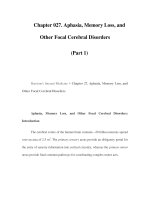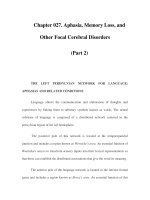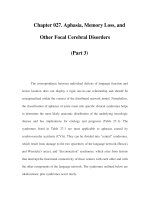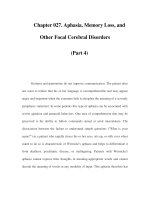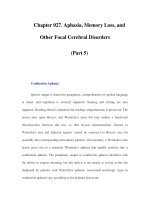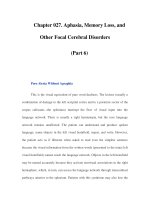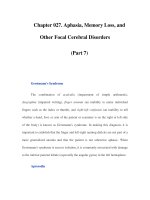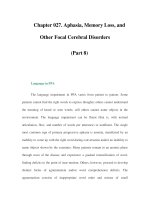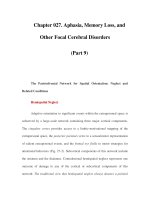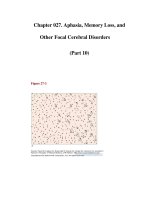Chapter 031. Pharyngitis, Sinusitis, Otitis, and Other Upper Respiratory Tract Infections (Part 4) docx
Bạn đang xem bản rút gọn của tài liệu. Xem và tải ngay bản đầy đủ của tài liệu tại đây (14.11 KB, 5 trang )
Chapter 031. Pharyngitis, Sinusitis, Otitis, and Other
Upper Respiratory Tract Infections
(Part 4)
Acute Sinusitis: Treatment
Most patients with a diagnosis of acute rhinosinusitis based on clinical
grounds improve without antibiotic therapy. The preferred initial approach in
patients with mild to moderate symptoms of short duration is therapy aimed at
facilitating sinus drainage, such as oral and topical decongestants, nasal saline
lavage, and—in patients with a history of chronic sinusitis or allergies—nasal
glucocorticoids. Adult patients who do not improve after 7 days, children who do
not improve after 10–14 days, and patients with more severe symptoms (regardless
of duration) should be treated with antibiotics (Table 31-1). Empirical therapy
should consist of the narrowest-spectrum agent active against the most common
bacterial pathogens, including S. pneumoniae and H. influenzae—e.g., amoxicillin.
No clinical trials support the use of broad-spectrum agents for routine cases of
bacterial sinusitis, even in the current era of drug-resistant S. pneumoniae. Up to
10% of patients do not respond to initial antimicrobial therapy; sinus aspiration
and/or lavage by an otolaryngologist should be considered in these cases.
Antibiotic prophylaxis to prevent episodes of recurrent acute bacterial sinusitis is
not recommended.
Surgical intervention and IV antibiotic administration are usually reserved
for patients with severe disease or those with intracranial complications, such as
abscess or orbital involvement. Immunocompromised patients with acute invasive
fungal sinusitis usually require extensive surgical debridement and treatment with
IV antifungal agents active against fungal hyphal forms, such as amphotericin B.
Specific therapy should be individualized according to the fungal species and the
individual patient's characteristics.
Treatment of nosocomial sinusitis should begin with broad-spectrum
antibiotics to cover common pathogens such as S. aureus and gram-negative
bacilli. Therapy should then be tailored to the results of culture and susceptibility
testing of sinus aspirates.
Chronic Sinusitis
Chronic sinusitis is characterized by symptoms of sinus inflammation
lasting >12 weeks. This illness is most commonly associated with either bacteria
or fungi, and clinical cure in most cases is very difficult. Many patients have
undergone treatment with repeated courses of antibacterial agents and multiple
sinus surgeries, increasing their risk of colonization with antibiotic-resistant
pathogens and of surgical complications. Patients often suffer significant
morbidity, sometimes over many years.
In chronic bacterial sinusitis , infection is thought to be due to the
impairment of mucociliary clearance from repeated infections rather than to
persistent bacterial infection. However, the pathogenesis of this condition is poorly
understood. Although certain conditions (e.g., cystic fibrosis) can predispose
patients to chronic bacterial sinusitis, most patients with this infection do not have
obvious underlying conditions that result in the obstruction of sinus drainage, the
impairment of ciliary action, or immune dysfunction. Patients experience constant
nasal congestion and sinus pressure, with intermittent periods of greater severity,
which may persist for years. CT can be helpful in determining the extent of
disease and the response to therapy. The management team should include an
otolaryngologist to conduct endoscopic examinations and obtain tissue samples for
histologic examination and culture.
Chronic fungal sinusitis is a disease of immunocompetent hosts and is
usually noninvasive, although slowly progressive invasive disease is sometimes
seen. Noninvasive disease, which is typically associated with hyaline molds such
as Aspergillus species and dematiaceous molds such as Curvularia or Bipolaris
species, can present as a number of different scenarios. In mild, indolent disease,
which usually occurs in the setting of repeated failures of antibacterial therapy,
only nonspecific mucosal changes may be seen on sinus CT. Endoscopic surgery
is usually curative in these patients, with no need for antifungal therapy. Another
form of disease presents with long-standing, often unilateral symptoms and
opacification of a single sinus on imaging studies as a result of a mycetoma
(fungus ball) within the sinus. Treatment for this condition is also surgical,
although systemic antifungal therapy may be warranted in the rare case where
bony erosion occurs. A third form of disease, known as allergic fungal sinusitis, is
seen in patients with a history of nasal polyposis and asthma, who often have had
multiple sinus surgeries. Patients with this condition produce a thick, eosinophilic
mucus with the consistency of peanut butter that contains sparse fungal hyphae on
histologic examination. Patients often present with pansinusitis.
Chronic Sinusitis: Treatment
Treatment of chronic bacterial sinusitis can be challenging and consists
primarily of repeated culture-guided courses of antibiotics, sometimes for 3–4
weeks at a time; administration of intranasal glucocorticoids; and mechanical
irrigation of the sinus with sterile saline solution. When this management approach
fails, sinus surgery may be indicated and sometimes provides significant, albeit
short-term, alleviation. Treatment of chronic fungal sinusitis consists of surgical
removal of impacted mucus. Recurrence, unfortunately, is common.
